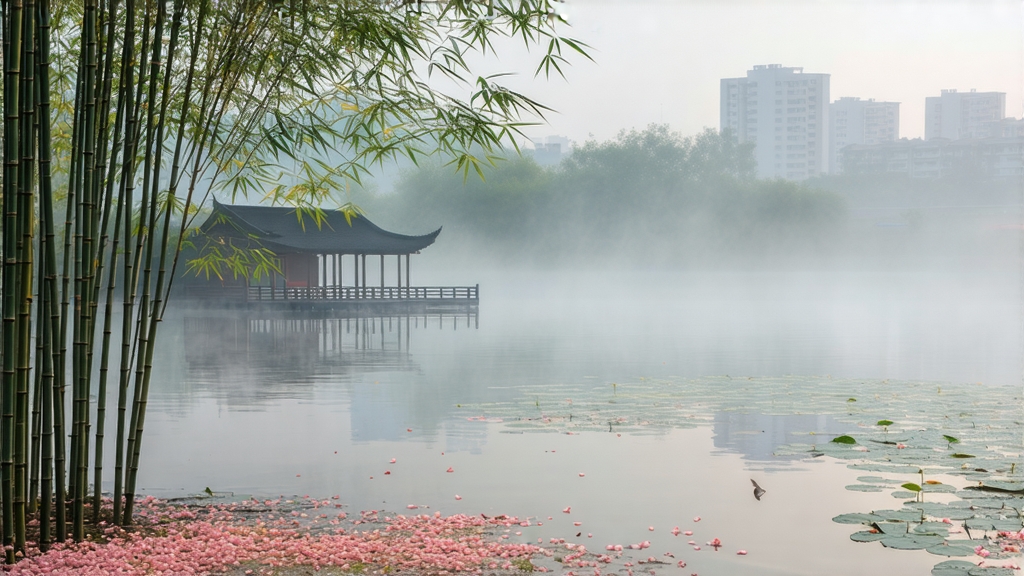
Biluochun, whose name literally means “Green Snail Spring,” is one of China’s ten most celebrated teas, yet it remains a delicate secret outside serious tea circles. Grown on the mist-lapped hillsides of Dongting Mountain in Taihu Lake, Jiangsu Province, this emerald-green tea is prized for its tiny spiral-shaped leaves, an aroma that carries the perfume of apricot blossoms, and a taste so soft and sweet it once compelled the Kangxi Emperor to rechristen it from the humbler “Xia Sha Ren Xiang” (“Scary Fragrance”) to the more elegant “Biluochun.”
Historical records trace Biluochun’s rise to the late Ming and early Qing dynasties, when monks in the Dongting temples offered the tea to traveling scholars. By 1699, imperial tribute lists document regular shipments to the Forbidden City, sealed in silver foil to preserve the volatile floral notes. Locals still recount how pickers once timed harvests to the first cry of the oriole, believing the bird’s voice opened the leaf’s cellular pores, allowing richer fragrance.
Today, only about 1,200 mu (roughly 80 hectares) of core-zone gardens on Dongting’s East and West peaks are recognized as producing authentic Biluochun. The cultivar itself is a small-leaf Camellia sinensis var. sinensis, locally called “Dongting Qunti,” a landrace evolved in the island microclimate. Two clones—Wuniuzao (“Black Bull Early”) and Xiaoye (“Small Leaf”)—are propagated for balanced yield and aromatics, but purists insist the original Qunti delivers the most complex cup.
Crafting Biluochun is a race against the clock. Picking begins around Grain Rain (mid-April) when nights are still cool and daytime lake mist diffuses sunlight, slowing photosynthesis and concentrating amino acids. Only the top bud plus the immediate unfolding leaf are plucked, yielding roughly 70,000 such sets per 500 g of finished tea. The pluckers’ fingers move like hummingbirds, dropping the fragile shoots into shallow bamboo baskets lined with nettle cloth to prevent bruising.
Within three hours the leaves reach the village workrooms where they undergo a unique “kill-green” choreography: a 150 °C wok, a handful of leaves, and a bare hand that never leaves the metal surface for more than four seconds. The master’s palm judges moisture, elasticity, and the exact moment when enzymes must be halted. This 6–8 min pan-fire is followed immediately by a low-temperature “li long” rolling: the still-warm leaves are cupped and rubbed against the wok in a figure-eight motion, coiling them into the signature spiral while secondary aromatics develop. Finally, a gentle 60 °C bake sets the shape and locks in the fragrance. From pluck to pack, no more than four hours elapse.
To brew Biluochun properly, think of the tea as a shy guest who dislikes loud company. Use spring water filtered to 50 ppm TDS; bring it to 75 °C, just when the kettle forms pin-size bubbles dubbed “crab eyes.” Warm a 150 ml glass or porcelain gaiwan, then add 3 g of tea—about a level teaspoon. Pour the water along the vessel wall so the spirals descend slowly, unfurling like green snails awakening from hibernation. Steep 45 s for the first infusion; subsequent steeps add 10 s. A five-step progression reveals a color arc from pale jade to liquid topaz, while the aroma migrates from fresh garden pea to white peach, then to a faintly marine note reminiscent of nori.
Tasting is best done in morning natural light. Hold the cup at eye level to observe the “down” (fine white hairs) dancing in suspension, a marker of early spring plucking. Sip with teeth slightly parted; draw the liquor across the tongue’s anterior sweet receptors, then exhale through the nose to capture the returning “hui gan” sweetness that arrives 3–4 seconds later. A top-grade Biluochun will leave a cooling sensation at the back of the throat, what locals call “ginger flower coolness,” and the cup’s dry aroma should persist for more than an hour.
Because the leaf is so delicate, storage is critical. Keep the tea in an unglazed clay jar nested inside a polyethylene bag flushed with nitrogen; maintain 45 % relative humidity and 5 °C. When traveling, carry only daily